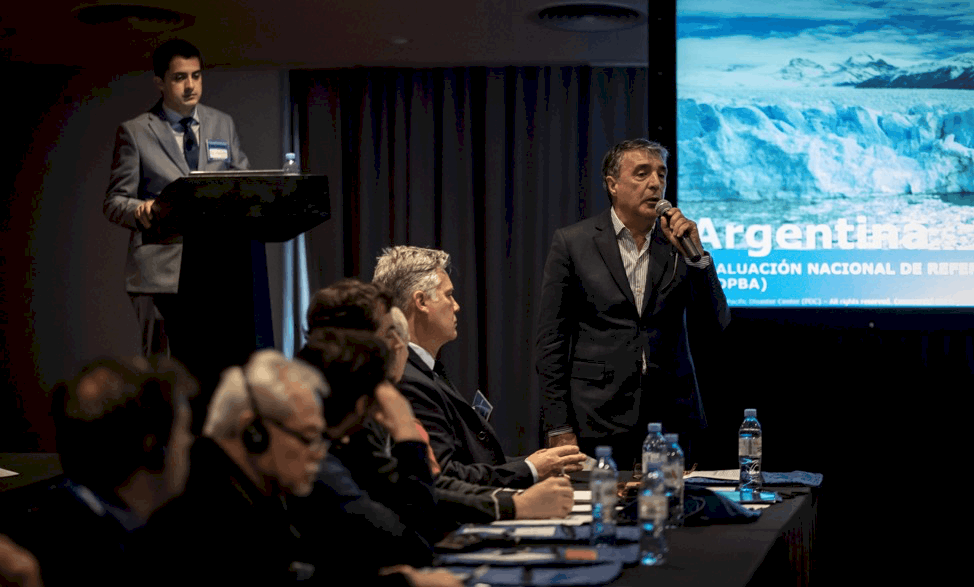As natural disasters increase in frequency and severity worldwide, affecting more people than ever before, the ability of countries to manage hazards has become an urgent global priority. Argentina has recognized this urgency as it confronts significant challenges from new and emerging risks related to climate change, urbanization, and migration.
To better understand the effects of these risks and those presented by existing hazards such as floods, wildfires, droughts, earthquakes, and volcanoes, the Government of Argentina kicked off a National Disaster Preparedness Baseline Assessment (NDPBA) with Pacific Disaster Center (PDC) in Buenos Aires on October 2, 2018—bringing together national leaders, disaster management practitioners, university and geospatial experts, and nongovernmental organizations from across the country. During the kick off event, PDC presented an overview of the program to be conducted over a 12-month period in collaboration with Argentina’s diverse disaster management stakeholder community which includes its Secretaría de Protección Civil at the national and provincial levels, the Ministry of Security, several universities, scientific groups, and nongovernmental organizations (NGOs) like Red Cross, ADRA, and Comisión Cascos Blancos to name only a few.
PDC is an applied research center managed by the University of Hawai‘i that specializes in risk and vulnerability research, advanced decision support tools, and best practices that promote risk-informed policies and decisions. The goal of the assessment with PDC is to provide broad insight into the key risk drivers across all of Argentina’s geographic regions and provinces. It will also highlight disaster management successes and identify any barriers that may contribute to reduced or increased losses over time. Outcomes of the assessment will help identify ways to enhance the progress of risk reduction capacity development throughout the country.
“The work we are doing with Pacific Disaster Center will ensure that Argentina’s investments are designed for long-term sustainability and protect the vitality and safety of all Argentinians into the future,” said Secretaría de Protección Civil Sub-secretariat of Operations, Dr. Daniel Russo. Dr. Russo added, “We must be able to anticipate and mitigate risks from natural hazards as well as developing threats like climate change, before they happen.”
According to Dr. Erin Hughey, PDC’s Director of Disaster Services, the NDPBA program is designed to provide the necessary scientific evaluation tools to strengthen governance, identify risk reduction investments, encourage interagency collaboration, and improve development planning, disaster preparedness, response, and recovery. She said, “The NDPBA is more than just an assessment. It’s a sustainable system for Argentina to access, understand, update, and apply critical risk information throughout all of its decision-making processes and organizations.” She explained that one of the greatest challenges to the effectiveness of disaster management is the compartmentalization of critical information within disparate organizations, which makes information access and interagency data sharing extremely difficult. Hughey described how the NDPBA supports the interoperability of collected data and information through PDC’s map-based DisasterAWARE platform. Information integrated into DisasterAWARE is provided back to stakeholders with assessment results visualized in a way that is easy to access and understand.
PDC disaster management and risk assessment experts Mr. Damon Coppola and Ms. Cassie Stelow guided participants through the NDPBA process. Stakeholders discussed identification of risks, vulnerabilities, and capabilities unique to Argentina. The knowledge offered by workshop participants provided a foundation for the program, which will continue throughout the coming year. Stelow emphasized the importance of working with stakeholders throughout Argentina to understand the unique drivers of risk within each province. According to Mr. Coppola, “the NDPBA directly supports the Sendai Framework priorities for action and, in many cases, it helps to operationalize them as well.”
Following completion of key project milestones, the NDPBA will culminate with the release of a 5-year Disaster Risk Reduction Action Plan codeveloped with Argentina’s project stakeholders. The action plan will guide new projects and help build national capacity to manage disaster risks—both new and old—while strengthening national resilience.

